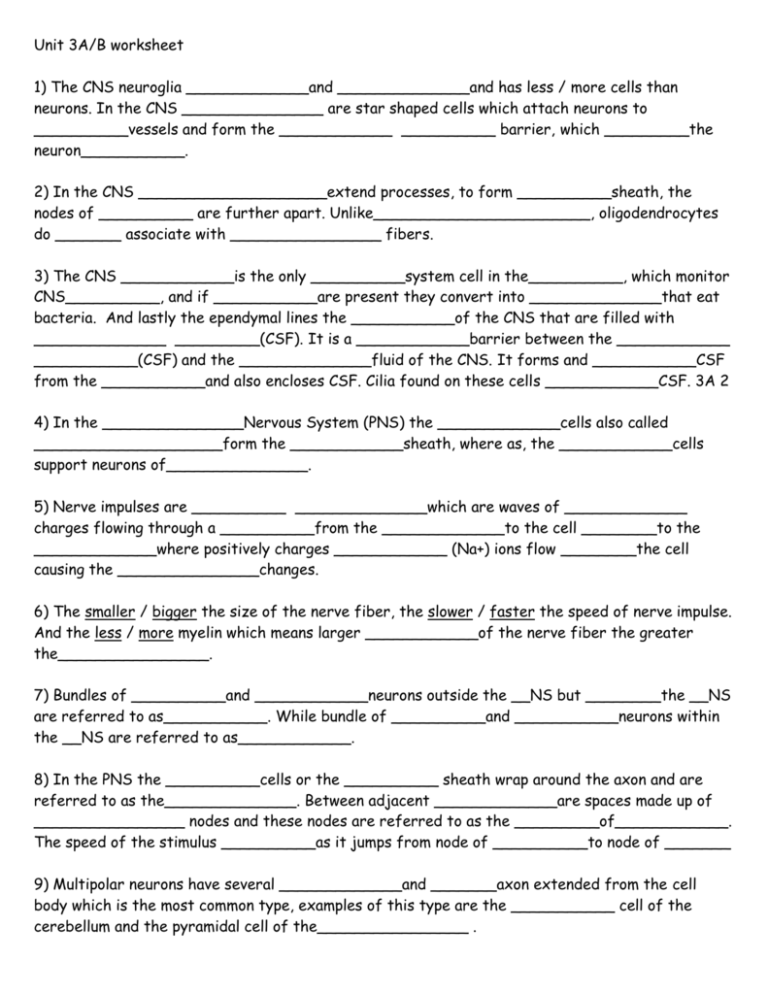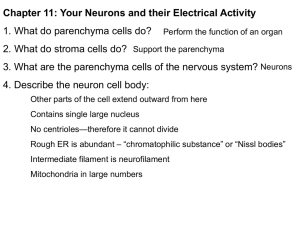3A/B Worksheet
advertisement

Unit 3A/B worksheet 1) The CNS neuroglia _____________and ______________and has less / more cells than neurons. In the CNS _______________ are star shaped cells which attach neurons to __________vessels and form the ____________ __________ barrier, which _________the neuron___________. 2) In the CNS ____________________extend processes, to form __________sheath, the nodes of __________ are further apart. Unlike_______________________, oligodendrocytes do _______ associate with ________________ fibers. 3) The CNS ____________is the only __________system cell in the__________, which monitor CNS__________, and if ___________are present they convert into ______________that eat bacteria. And lastly the ependymal lines the ___________of the CNS that are filled with ______________ _________(CSF). It is a ____________barrier between the ____________ ___________(CSF) and the ______________fluid of the CNS. It forms and ___________CSF from the ___________and also encloses CSF. Cilia found on these cells ____________CSF. 3A 2 4) In the _______________Nervous System (PNS) the _____________cells also called ____________________form the ____________sheath, where as, the ____________cells support neurons of_______________. 5) Nerve impulses are __________ ______________which are waves of _____________ charges flowing through a __________from the _____________to the cell ________to the _____________where positively charges ____________ (Na+) ions flow ________the cell causing the _______________changes. 6) The smaller / bigger the size of the nerve fiber, the slower / faster the speed of nerve impulse. And the less / more myelin which means larger ____________of the nerve fiber the greater the________________. 7) Bundles of __________and ____________neurons outside the __NS but ________the __NS are referred to as___________. While bundle of __________and ___________neurons within the __NS are referred to as____________. 8) In the PNS the __________cells or the __________ sheath wrap around the axon and are referred to as the______________. Between adjacent _____________are spaces made up of ________________ nodes and these nodes are referred to as the _________of____________. The speed of the stimulus __________as it jumps from node of __________to node of _______ 9) Multipolar neurons have several _____________and _______axon extended from the cell body which is the most common type, examples of this type are the ___________ cell of the cerebellum and the pyramidal cell of the________________ . 10) The bipolar neuron has _______ dendrite and _______ axon with the cell body in_________, these are rare and found only in specialized ___________organs such as the retina of the _____ and olfactory epithelium of the_________. 11) The unipolar or _________________has _______ process where a dendrite ________with an axon, these are formed from __________neurons in the_____________. These are mainly found in the __NS, but seldom in the __NS where they are found only in _________root ganglia of the spinal cord and sensory __________of cranial nerves in which ___________ neurons bring information to the CNS. 12) Interneurons or _____________neurons, are the most ____________neurons, they are ___% of the neurons found in the body and are located in the cerebral___________, the cerebellum and the ___________cord. They carry impulses from __________neurons to __________neurons and interneurons to___________. Examples of these would be the _________cells of the cerebellum and the _____________cells of the cerebrum which are ____________neurons which are found in __________matter and are _______________in the most part. 13) In an action_____________, the stimulus is sent through the ____________from the ______________to the cell body to the___________. As a stimulus transfers from cell to cell it goes from pre-synaptic neuron which would be the _________that it originated from, to the post-synaptic neuron which would be the ___________of the neuron it is transferring to and again to the next _________eventually to the ________which could be a _______or a gland. The synaptic cleft is the _________between the ________-synaptic neuron (axon) and the _______synaptic neuron (dendrite). 14) Most synapses, are ____________synapses in which the ___________________is secreted by the _______-synaptic cell which then diffuses across the synaptic ________to the _______synaptic cell. This occurs in a ______way direction and is _________than the action potential. 15) Regeneration of nervous tissue is __________because at 6 months of age the _________ apparatus of the neurons is________. Neurons don’t do_________, as they are too__________. After that the __NS axons may be replaced if the _________cells are okay, and they can form regeneration neuron________. In the CNS ___________________do not promote regeneration following damage because they die and the ______________stop the process and make scar tissue which physically prevents_________________. Therefore, injury to the CNS is usually _________________ while injury to the PNS may be______________. 16) Protection for the CNS is done by the________, ________and the _________________ ________(CSF). The brain is further protected from harmful substances by the___________ ____________ ___________. 17) Meninges are made up of _________connective tissue membranes external to the CNS which are the _______ mater which is very________, the ___________mater which has a spider _______look and contains ________vessels along with __ __ __ and the _______mater which is very __________ tissue. 18) The functions of the meninges are to _________and _________the CNS, and also protect ____________vessels and _________venous ___________that _________CSF back to the___________, as well as contain the __ __ __ and form ____________ in the brain. 19) The dura mater is very _________and is composed of ______fibrous connective tissue layers around the brain but only _______ layer around the spinal cord. The two layers separate in certain areas and form dural_________. The dural _______extend between ___________ referred to as the ________ ___________which attaches to the crista galli of the __________ bone to limit its___________________. 20) The arachnoid mater is the __________layer and it forms the loose brain ___________and is separated from the dura mater by the _____________space. Beneath the arachnoid mater is a wide space referred to as the ____________space which is filled with _________and large ____________vessels. Arachnoid _______ protrude superiorly and permit CSF to be _________ into the ___________ blood. 21) The _____mater is the __________layer and is the _________connective tissue that clings tightly to the __________. 22) Cerebrospinal fluid (CSF) is a __________solution similar to blood__________, although it contains less ____________ and has different______. Its function is to________, gives ____________, prevents delicate brain matter from being___________, protects, ________ and carries __________ signals through it.









